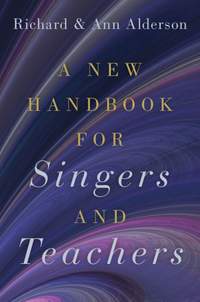Contents
- PART ONE: HOW TO SING
- Chapter 1: Introduction
- Chapter 2: Respiration
- Physical Elements of the Vocal Mechanism
- Breathing to Sing
- Types of Breathing
- Develop Coordinated Breathing
- Breathing and the Musical Phrase
- Symptoms of Improper Breathing
- Additional Breathing Exercises
- Helpful Sports Analogies
- Other Useful Analogies
- Chapter 3: Phonation
- Making the Proper Sound
- Coordinating Respiration with Phonation
- Initiating the Tone
- Sustaining the Tone
- Moving from Note to Note
- Releasing the Tone
- Finding and Refining the Proper Tone
- Dealing with Nasality
- Exercise Remedies for Nasality
- Vocalises for Nasality
- Vibrato
- History of Vibrato
- Dealing with Vibrato
- Breathiness
- Hoarseness or Huskiness
- Harshness or Stridency
- Muffled or Swallowed Tone
- Hollow or Hooty Quality
- Other Analogies
- Chapter 4: Resonance
- Types of Resonance
- Vocal Resonators
- Developing a Rich Voice
- Respiration--Phonation--Resonance
- Resonance Exercises
- Chapter 5: The Singing Vowel
- Instrumental Characteristics of Vowels
- The Fixed Formant Theory of Vowels
- Making a Proper Vowel Sound
- Vowel Unification Vocalises for all Voices
- Vowel Migration
- Vowel Modification
- Chapter 6: Registers and Registration
- Dealing with Registers
- Dealing with Registration
- Changing Registers Smoothly: Males
- Changing Registers Smoothly: Females
- Chapter 7: Articulation
- Making Sense out of Sound
- Sung Language vs. Spoken
- Articulation Exercises and Vocalises
- The trouble with /R/
- Special Problems of Articulation
- Chapter 8: Fundamental Diction for Singers
- Italian Diction
- Rules of Pronunciation
- Latin Diction
- Rules of Pronunciation
- French Diction
- Vowels
- Nasal Vowels
- Semi-vowels and Glides
- Consonants
- Special Rules of Pronunciation
- German Diction
- Vowels
- Diphthongs
- Consonants
- Some General Rules in Singing
- The Glottal Attack
- Ach-Laut and Ich-Laut
- Special Rules for the Letter /G/
- Chapter 9: Audition Strategies
- General Principles
- Physical Strategies
- Psychological Strategies
- Final Suggestions
- PART TWO: HOW TO TEACH SINGING
- Chapter 10: Basic Concepts of Voice Teaching
- General Vocal Pedagogy
- A Broad Technical Base
- Instructional Cue Card
- Using the Cue Card
- Choosing Literature
- Two Golden Rules
- Style and Musicianship
- Reinforcement
- Expectations
- If the Student is not Making Progress
- Logistics
- Length of Lesson
- Setting a Price
- Chapter 11: Organizing a Training Program
- Determine the Level of the Singer
- Listen to the Singer and Analyze the Performance
- Apply Four Key Principles
- Determine a General Training Plan
- Determine a Logical Starting Point
- Constructing Coordinated Lesson Plans
- The Individual Lesson Plan
- Communicating Information
- General Benefits of Lesson Plans
- Teaching Aids
- Summary
- Chapter 12: Basic Vocal Exercises
- Using Basic Vocal Exercises
- Warm-up Exercises
- Skill Exercises
- Selecting Exercises
- Assigning Exercises
- Incorporating Exercises and General Training
- Specific Lesson Organization
- Chapter 13: Teaching Breathing Techniques
- A Concise Explanation of the Singing Breath: For Beginners
- A Logical Presentation of the Breathing Process
- A Concise Explanation of Interrelated Functions
- A Sample Discussion of Inhalation
- A Sample Discussion of Exhalation
- Teaching the Techniques of Proper Respiration
- Relating the Functions of the Singing Breath
- Analyzing a Singer's Breathing Skills
- Discussing Various Types of Breathing
- Applying Appropriate Breathing Techniques
- Correcting Errors
- Breathing Exercises and Correlated Use
- Chapter 14: Teaching Phonation Skills
- Teaching Techniques of Phonation: Basic Principles
- Vocal Registers
- Teaching Different Genders
- Further Considerations
- How to Analyze Vocal Sound
- How to Design a Training Program
- Solutions Related to Visual Clues
- Solutions Related to Audible Clues
- Other Common Phonation Errors
- Sample Phonation Exercises
- Chapter 15: Training the Resonators
- The Resonating System
- Adapting the Resonators
- Types of Resonance
- Applying Vowel Modification
- Vowel Modification Exercise Charts
- Constructing the Charts
- Establishing Register Changes
- Applying Resonance Principles
- Respiration Plus Resonance
- Using Repertory to Train the Resonators
- Resonance Problems and Solutions
- Chapter 16: Teaching Articulation Techniques
- Respiration + Phonation + Resonance + Articulation
- Identifying Articulators and Specific Types of Movement
- Importance of Training Articulation
- Elements of Articulation
- Teaching Articulation Techniques
- Diction Considerations
- Training the Articulators
- Articulation Problems and Solutions
- Final Elements of Articulation Training
- Chapter 17: Teaching Young Changing Voices
- Normal Angst
- Principles for Teaching Young Singers
- Fundamental Concepts
- Repertory
- Peer Reinforcement
- Young Male Voices
- Countertenors or Male Altos
- Exercises Specific to Boys' Voices
- Young Female Voices
- Exercises Specific to Girls' Voices
- Assigning Repertory
- Chapter 18: Teaching Aging Voices
- General Considerations
- Physical Factors of Aging Voices
- Psychological Elements Related to Singing
- Specific Aspects of the Aging Voice
- Technical Adaptations
- Exercises and Correctives
- Physical Fitness and Vocal Fitness
- Final Considerations




